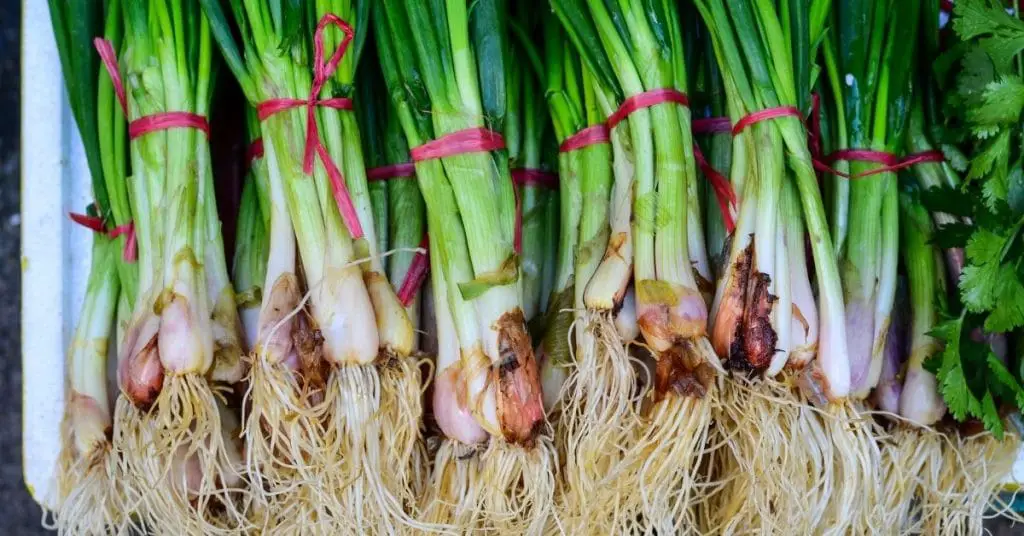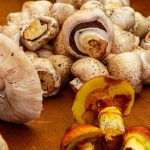In short, yes, you can freeze green onions for later use, but the texture will change, making them less crisp. They are still suitable for cooked dishes and can save money and reduce food waste if properly stored.
Raw or cooked, green onions add a great pop of flavor to any savory dish. Whether baked into a quiche or muffins, added to an omelet, stir-fry, or used in a salad, green onions are less assertive than regular large onions yet still bring a huge amount of flavor.
Although they are a spring vegetable, you can generally buy green onions in grocery stores year-round. Fresh green onions don’t have a long shelf life. Often, you only need one or two sprigs and the rest of the bunch goes to waste.
Whether your own harvest has been too plentiful or your store purchase was more than needed, you can freeze green onions for up to 10 months to prolong their shelf life. No reason to toss any slimy scallions again.
Here is exactly what you need to know about freezing green onions and how to store them.
Can Green Onions Be Frozen?
Yes, you can freeze green onions for later use. It is important to note that the crisp texture will change somewhat in the freezer. Ice crystals form, damaging the cell walls on freezing. This results in a softer, less crisp vegetable once defrosted.
All this really means is that the frozen green onions won’t be suitable in a salad or where they are needed to bring crispness into a dish. However, they are perfectly fine for use in any cooked meal. Freezing green onions can, therefore, save you money, food waste, and preparation time.
Due to the strong onion flavor and odor, improperly packed green onions will easily permeate their flavor into surrounding food items. It is essential to package and seal the spring onions well before placing them in the freezer or fridge.
How To Freeze Green Onions
Step 1: Sort and Clean
Remove any damaged or slimy leaves from the bunch of green onions as they won’t freeze well. Trim off the root end.
Step 2: Wash
Wash the fresh green onions thoroughly to remove any sand or bugs. Fill a bowl with water and add one to 2 tablespoons of salt or vinegar. Soak and wash the green onions in the vinegar water and rinse well.
Step 3: Dry and Chop
Once clean, pat dry the green onions with a clean kitchen or paper towels to remove as much moisture as possible. Excess moisture will form crystals on freezing and cause textural damage.
Working on a cutting board, chop the leaves into the desired size pieces. The pieces should preferably be the same length. If the green onion has a small bulb, you can freeze these separately as well.
Step 4: Flash Freeze
Line a baking sheet with parchment paper. Place the bulbs and chopped green onions on the baking sheet spread out in a single layer. Place it in the freezer.
Only leave them for one hour. This should be long enough to freeze sliced green onions. You do not want them to be exposed to air for too long in the freezer.
Flash freezing prevents the green onions from clumping together once packed. This allows you to only take out as many as you need at a time for cooking and keep the rest frozen.
Step 5: Pack
Once fully frozen, remove the baking sheet from the freezer and pack the green onions into a resealable freezer bag straight away.
Press out as much air as possible and seal tightly. The more air around the scallions, the greater chance there is of freezer burn developing and textural damage as a result .
If you don’t have freezer bags, use a freezer safe container. When you store frozen green onions it is important that the storage container is airtight to prevent the strong flavor from permeating surrounding foods.
Step 6: Label and Freeze
Write the date of freezing on the packaging and store the frozen green onions back in the freezer.
How To Thaw Frozen Green Onions
Since green onions are best used in cooked dishes after freezing, there is no need to defrost them. You can add green onions straight out of the freezer to the dish you are cooking.
If you are adding them to a baked dish such as a quiche or savory muffins, thaw green onions in the refrigerator or place the sealed bag in a cold water-bath for a few minutes. They defrost very quickly.
Types of Green Onions
Green onions, also known as scallions or spring onions, are vegetables in the same Allium family as garlic, shallot, leek, chives, and onions.
With a milder taste than most onions, they have long thin hollow leaves and some varieties have a small undeveloped white bulb from which the leaves grow.
Green onion leaves can be used as a vegetable raw or cooked in olive oil, but mostly they are chopped and added as flavoring to other dishes such as soups, stews, stir-fry, salads, eggs, or quiche, in a similar way to garlic and onions.
How to Preserve Green Onions
If you purchase them in a bunch with roots, the best way to preserve them is to gently place the unwrapped green onions in a jar with a little bit of water (about 1 inch or 2cm). Similar to how you keep cut flowers fresh. Do not overfill your water or it will rot the onion stalks and leaves.
You can also wrap your scallion stalks in paper (such as newspaper or paper towel) and place it in the fridge to keep it fresh for a few days.
FAQs
Conclusion
If you have too many green onions on hand, keeping them frozen (and stored properly) will allow you to use your harvest all year round.
Make sure the scallions are very well sealed in an airtight bag to prevent surrounding foods from absorbing the odor and flavor. This could be unpleasant especially when you have milk or sweet baked goods nearby.
A fantastic addition to soups, stews, breakfast scramble, salads, quiches, stir fries, and other delicious recipes, green onions can be added to almost any savory dish to bring a wonderful pop of flavor.
Up next: Can You Freeze Cucumbers?
*Image by depositphotos.com/phuongphoto








